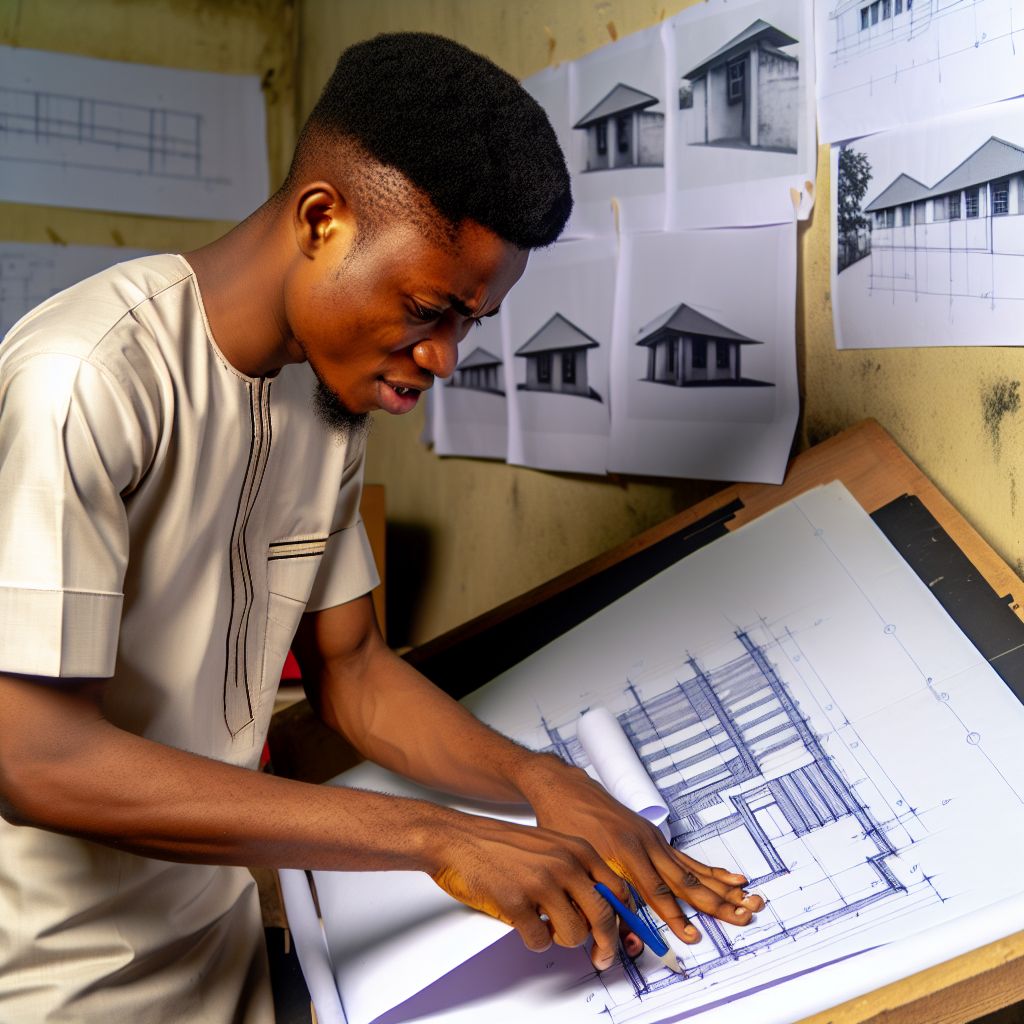Introduction
When it comes to Nigerian architectural designs, climate plays a significant role in shaping them.
Nigeria is a country with diverse climates, ranging from tropical to arid regions.
Each climate zone has a unique influence on architectural styles.
Historical Perspective
Traditional Nigerian architectural designs were adapted to the local climate by:
- Using materials readily available in the region.
- Incorporating natural ventilation techniques to combat heat.
- Building structures with high roofs for air circulation and cooling.
- Creating shaded outdoor spaces for comfort during hot weather.
- Using earth tones in building facades to blend with the landscape.
Ancient civilizations in Nigeria built structures to withstand harsh weather conditions:
- The Nok culture created terracotta sculptures and pottery with thick walls to keep items cool.
- The Igbo people constructed round mud houses with thatched roofs for insulation.
- The Yoruba tribe built courtyard houses with open spaces for natural light and ventilation.
- The Hausa-Fulani architecture featured flat roofs for rainwater collection and storage.
- The Benin Kingdom used bronze casting techniques to create intricate architectural details.
Modern Influences
Contemporary architects in Nigeria have been actively incorporating climate-conscious design principles into their projects.
Eco-friendly building materials are being used to mitigate the environmental impact of architectural structures.
Materials such as bamboo, recycled wood, and locally-sourced stone are popular choices for sustainable construction.
Architects are also implementing innovative design strategies to optimize natural lighting and ventilation in buildings.
Large windows, skylights, and open floor plans are common features in modern Nigerian architectural designs.
Roof gardens and green roofs are being utilized to reduce heat absorption and provide natural insulation.
Rainwater harvesting systems and solar panels are integrated into building designs to promote energy efficiency.
Architects are embracing the concept of bioclimatic architecture, which seeks to harmonize the built environment with nature.
By considering the local climate and environmental conditions, architects are able to create buildings that are both functional and sustainable.
Overall, the influence of climate on Nigerian architectural designs has spurred a movement towards eco-friendly and sustainable practices in modern architecture.
Find Out More: Famous Nigerian Architects and Their Iconic Works
Influence of Climate on Architectural Designs in Nigeria
In Nigeria, the influence of climate on architectural designs is evident through regional variations.
These variations are visible in the differing architectural styles across regions in the country.
Arid Northern Region
In the arid Northern region of Nigeria, temperatures can soar to extreme levels.
Architectural designs have adapted to the harsh climate.
Buildings are often constructed with thick walls and small windows.
This design provides insulation against the scorching heat.
One of the most prominent features is the use of courtyards.
These enclosed spaces provide shade and ventilation.
Courtyards also create a sense of privacy and security in the desert environment.
The use of earthy materials such as mud bricks and thatch roofs is common.
These materials help regulate indoor temperatures and protect against the heat of the sun.
Tropical Southern Region
In contrast, the tropical Southern region of Nigeria experiences heavy rainfall and high humidity.
Architectural designs have evolved to suit the wet climate.
Buildings are often elevated on stilts to prevent flooding.
This elevation allows for air circulation underneath.
Architectural designs in the Southern region also utilize moisture-resistant materials.
Common materials include concrete and metal.
These materials prevent damage from frequent rain and humidity.
Large windows and open spaces are common features.
These design choices allow for ample ventilation and natural light.
This approach helps reduce reliance on artificial cooling systems.
Regional Contrasts
When comparing the architectural designs of the arid Northern region to the tropical Southern region, stark contrasts emerge.
While buildings in the North emphasize insulation, those in the South prioritize ventilation.
Despite these differences, both regions share a common architectural heritage.
Transform Your Career with Expert Guidance
Get personalized mentorship consulting that’s tailored to your unique path. Our expert advice is actionable and exclusive.
Get StartedThis heritage is rooted in traditional building techniques and local materials.
The connection to the natural environment reflects sustainable design principles.
Gain More Insights: Surveying in Rural vs. Urban Areas: Key Differences
Cultural Significance
Architectural designs in Nigeria are influenced by climate and cultural diversity.
This fusion of climate-responsive architecture and cultural identity is evident in various styles.
Traditional architectural designs vary across ethnic groups, reflecting unique identities.
For example, the Hausa people’s mud houses showcase intricate mud plastering techniques.
Many Nigerian architects focus on preserving traditional building techniques despite modernization.
This practice honors the country’s heritage and ensures sustainable construction methods.
Contemporary architecture blends traditional techniques with modern innovations effectively.
Architects often incorporate natural ventilation systems, shaded outdoor spaces, and climate-responsive materials.
Nigerian architects integrate cultural elements like traditional patterns and motifs into their designs.
This enhances the aesthetic value and strengthens the connection to local cultural heritage.
Community engagement is vital in climate-responsive architecture in Nigeria.
Architects incorporate local knowledge, traditions, and preferences during the design process.
This collaborative approach creates structures that resonate with the cultural identity of the people.
Nigerian architects merge climate-responsive design principles with cultural influences.
This creates sustainable and resilient buildings suited to local climates and environmental conditions.
These structures minimize energy consumption, reduce carbon footprints, and promote occupants’ well-being.
The influence of climate on architectural designs fosters cultural exchange among different ethnic groups.
Sharing architectural techniques, materials, and design philosophies preserves Nigeria’s diverse heritage.
Promoting climate-responsive architecture rooted in cultural identity offers economic benefits to local communities.
By incorporating traditional techniques and materials, architects support local artisans and craftsmen.
This creates sustainable livelihood opportunities and economic empowerment.
Climate-responsive architectural designs serve as valuable educational resources.
They offer insights into Nigeria’s rich architectural heritage, promoting cultural awareness.
This inspires future generations to draw from traditional practices in their designs.
Integrating climate-responsive architecture and cultural identity fosters social cohesion.
Celebrating cultural heritage through architectural designs strengthens community pride.
People develop a deeper connection to their roots and contribute to preserving their identity.
The influence of climate on architectural designs reflects the country’s diverse cultural heritage.
By embracing climate-responsive architecture, Nigerian architects create sustainable, resilient, and culturally significant structures.
Such buildings resonate with the people and the environment.
Find Out More: Scholarships for Marine Engineering Students in Nigeria

Sustainability Practices
Nigerian architectural designs incorporate sustainable practices that aim to reduce energy consumption and minimize carbon footprint.
These practices not only benefit the environment but also promote efficient building design and construction methods.
Identifying Sustainable Practices
- Use of locally sourced materials: By utilizing materials that are readily available in the local area, architects reduce the need for transportation, thus lowering energy consumption.
- Passive design strategies: Incorporating passive design elements such as natural ventilation, shading devices, and thermal mass helps to reduce the reliance on artificial cooling and heating systems.
- Water conservation techniques: Implementing rainwater harvesting systems and water-efficient fixtures in buildings help to conserve water resources and reduce the building’s overall environmental impact.
Importance of Climate-Adaptive Design
Climate-adaptive design plays a crucial role in promoting environmental stewardship in Nigerian architectural designs.
By considering the local climate and environmental conditions, architects can create buildings that are energy-efficient and sustainable.
- Enhanced comfort and livability: Climate-adaptive designs ensure that buildings are comfortable to occupy, even in hot and humid climates, by incorporating features such as natural ventilation and shading.
- Improved energy efficiency: By optimizing building orientation, using appropriate materials, and integrating passive design strategies, architects can minimize energy consumption and reduce the carbon footprint of a building.
- Resilience to climate change: Climate-adaptive designs help buildings to withstand extreme weather events and changing climatic conditions, ensuring long-term sustainability and durability.
Sustainable practices and climate-adaptive design are essential aspects of Nigerian architectural designs that benefit the environment.
They also contribute to the overall quality and longevity of buildings.
By incorporating these principles into their work, architects can create buildings that are efficient, resilient, and environmentally responsible.
Find Out More: Marine Engineering Internships and Apprenticeships
Impact of Climate on Nigerian Architectural Designs
The influence of climate on Nigerian architectural designs is undeniable.
The hot and humid climate in Nigeria has shaped the way buildings are constructed and designed.
Architects in Nigeria have adapted their designs to accommodate the climate.
They use materials and techniques that help regulate temperature and provide ventilation.
It is crucial for architects to consider climate factors when planning and designing buildings.
By doing so, they can create sustainable structures that are energy-efficient and comfortable for occupants.
The integration of climate-responsive design principles in Nigerian architecture is essential for a sustainable future.
This approach improves the overall quality of buildings and reduces their environmental impact.
Therefore, architects must continue to prioritize climate considerations in their designs.
Doing this creates a built environment that is resilient, sustainable, and beneficial for both people and the planet.
Additional Resources
(PDF) Climate Change and Architectural Practice in Nigeria
Evolving trends and challenges in sustainable architectural design …




